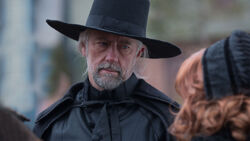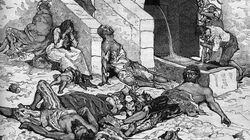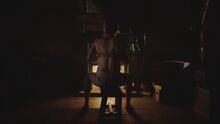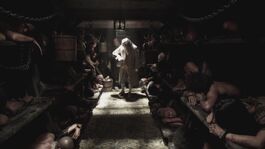| Warning! Archive of official material released as extra bonus on the discontinued official website. Therefore, it should be considered for consultation only. |
| “ | Isaac: Have I passed over? Did I make it to Heaven? Or am I in Hell? Dr. Wainwright: Neither Heaven nor Hell, Sir. Merely Salem. |
” |
— Rescuing a lost soul[src]
| ||
The colonial history of the United States covers the history of European settlements from the start of colonization of America until their incorporation into the United States. In the late 16th century, England, France, Spain and the Netherlands launched major colonization programs in eastern North America. European settlers came from a variety of social and religious groups. No aristocrats settled permanently, but a number of adventurers, soldiers, farmers, and tradesmen arrived. [1]
Apparel
Dressing differently was dangerous in Salem

John Hale perfectly in line with the Puritanical dress code
Women’s fashion in Salem at the time of the trials was very conservative. The church dictated the dress code, and women were to wear large dark outfits that hid their form and most of their skin. In fact, convicted witch Sarah Bishop was in part accused thanks to her “flamboyant dress.”
TV show costumes Over 600 costumes and 300 shoes help bring Salem to life. Costume designer Joseph A. Porro reveals how he dressed Salem Village with both history and fantasy. For further information, see Costumes.
Indigenous people
- Main article: Algonquian peoples

Anne Hale facing an Indigenous man in the woods near Salem
New England has long been inhabited by Algonquian-speaking native peoples, including the Abenaki, the Penobscot, the Pequot, the Wampanoag, and many others. During the 15th and 16th centuries, Europeans such as Giovanni da Varazzano, Jaques Cartier and John Cabot charted the New England coast. The earliest known inhabitants of New England were Native Americans who spoke a variety of the Eastern Algonquian languages.
According to archaeological evidence, the indigenous people of the warmer parts of Southern New England had started agricultural endeavors over a thousand years ago. They grew corn, tobacco, kidney beans, squash, and Jerusalem artichoke. Trade with the Algonquian peoples of Vermont, New Hampshire, and Maine, where the growing season was shorter, likely provided for a robust economy.
As early as 1600, French, Dutch, and English traders, exploring the New World, began to trade metal, glass, and cloth for local beaver pelts. The traders and sailors brought previously unknown European diseases, especially smallpox, measles, malaria, and yellow fever, which quickly spread along trade routes and killed a majority of the Indians in the region by the 1630s.
Paganism and Superstitions
Witchcraft Wasn't Always Dark
Witchcraft began as a way for superstitious farmers to grow their crops. They cast spells and laid charms on their farms in order to encourage their plants to grow large and harvests bountiful. It did not take long for this to transform into “dark magic,” and the Puritanical villagers of Salem had no tolerance for anything with an unexplainable or extraordinary nature. Seizures were thought to be signs of possession.
Witch Trials
The Trials were held for sixteen months. Of the 72 accused souls tried for witchcraft between February 1692 and May 1693, 20 of them were put to death. Perhaps this is fewer lives lost than you thought. Perhaps it’s more. In either case, it is 20 lives too many. And their stories haunt Salem’s history to this day.
Plague

An outbreak of the plague
Plagues are not just a Bible story. A plague – or a Witch Pox in Salem – was any disease that decimated a population. People believed that it was a punishment from God. It was the only way to make sense of such a devastating loss of life. The best-known cases of plague in the Middle Ages are the ones who decimated entire villages of Europe, under the name of Black Death. For many years, any doctor who tried to cure a plague was labeled a witch. The pox was God’s will after all and must be a fitting punishment to any who succumb to it. However, as the years went on and the death toll from disease mounted, even Puritan gradually accepted inoculation as an acceptable alternative to death. Thanks in part to a leading inoculation advocate, Cotton Mather.
Policy and Justice
- Main article: Torture Devices
The Puritan movement in England was riven over decades by emigration and inconsistent interpretations of Scripture, and some political differences that surfaced at that time. Justice was perpetrated by a council of senior members of the community, known as selectmen, formed exclusively by men.
Puritan
The Puritans were a group of English Protestants in the 16th and 17th centuries, including, but not limited to, English Calvinists. Puritanism in this sense was founded by John Calvin from the clergy shortly after the accession of Elizabeth I of England in 1558, as an activist movement within the Church of England.
Religion
- Main article: Deity

Increase Mather mortifies his flesh
The idea of personal Biblical interpretation, while central to Puritan beliefs, was shared with most Protestants in general. They believed that man existed for the glory of God, that his first concern in life was to do God's will and so to receive future happiness. Puritan believed in demonic forces, as did almost all Christians of this period. Puritan pastors undertook exorcisms for demonic possession in some high-profile cases, and believed in some allegations of witchcraft. The Puritan, as well as other forms of worship of the emigrants to the New World, consisted of sermons that came to last even six hours and the Mass was held every day, not just on Sundays. Also were treated with distrust all the gold vestments in Church, decorations (eg candles, christmas tree, nativity scene) because they were perceived as idolatry and pagan heritage.
Slavery
English Slavery was based on Religion
The first Africans brought to America were indentured servants. They would work a length of time in order to pay back the debt of the voyage to the new world, then be free. The English had no tradition of enslaving based on race… only religion. They enslaved non-Christians, only freeing them once they had converted. However, in the mid seventeenth century, a change occurred. The colonies realized it made more economic sense to hold onto this labor for as long as possible, so slavery began to be measured on an unchangeable metric: skin color.

Slave ship from the Old World
Legal Slavery in America Started in Massachusetts
Massachusetts was the first colony to legally recognize slavery. They did it in 1641. With this law, the state sanctioned a legacy in the United States far more damning and wide reaching than the witch trials of Salem Village.
Slave Ship Captains Packed Slaves Like Cargo
Owners of slave ships considered their cargo to be no different than any other commodity. They packed slaves as tightly as they would coffee, tobacco or lumber. Often slaves were sardined together so closely there was no room to walk between them. Thanks to this practice, disease spread like wildfire on these ships and 20% of all inbound slaves did not survive. Small pox, yellow fever, and dysantary were common. Malaria first came to America via slave ship.
Social Life
Puritan placed family at the center of their societies, as an organization to facilitate their devotion to God. Based on Biblical portrayals of Adam and Eve, Puritan believed that marriage represented one of the most fundamental human relationships rooted in procreation, love, and, most importantly, salvation. Furthermore, marriage represented not only the relationship between husband and wife, but also the relationship between spouses and God. Puritan husbands commanded authority through family direction and prayer. The female relationship to her husband and to God was marked by submissiveness and humility
Videos
|
| ||||||||||||||

